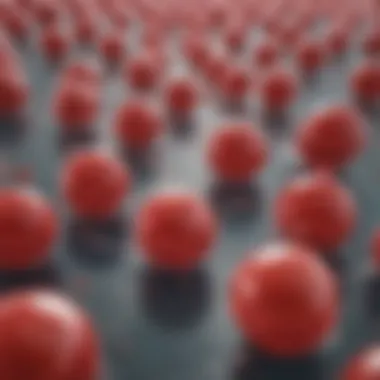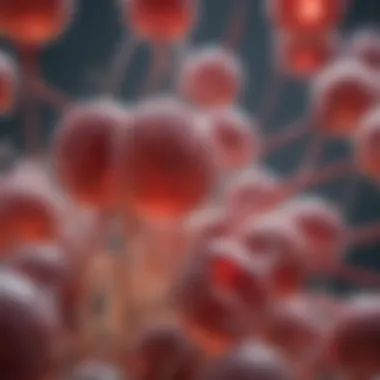Platelets and Chemotherapy: Interactions and Implications


Intro
The interplay between platelets and chemotherapy presents a complex landscape worthy of thorough exploration. Chemotherapy is a cornerstone treatment for various malignancies, but it often comes with significant side effects. One critical side effect is the impact on platelet function, which can lead to complications like thrombocytopenia. Understanding this relationship is essential not only for enhancing patient care but also for advancing cancer treatment protocols.
In this article, we will delve into the underlying biological mechanisms affected by chemotherapy that influence platelet activity. We will also investigate the clinical significance of changes in platelet counts and their implications for cancer treatment outcomes. Furthermore, recent studies that provide fresh insights into the relationship between platelets and cancer progression will be analyzed, showcasing potential pathways for therapeutic strategies.
Research Overview
Key Findings
Recent research sheds light on several significant findings related to platelets and chemotherapy:
- Impact on Platelet Function: Chemotherapy can alter platelet activation and aggregation, leading to increased risk of thrombotic events.
- Thrombocytopenia: Many chemotherapeutic agents induce thrombocytopenia, which can complicate treatment regimens and increase patient morbidity.
- Platelet Role in Metastasis: Emerging studies indicate that platelets may play a role in tumor metastasis and treatment resistance, suggesting a potential target for therapeutic intervention.
Study Methodology
The studies reviewed often utilize a combination of clinical trials and laboratory investigations. These approaches include:
- Patient Data Analysis: Most studies involve analyzing the platelet counts and functionality in cancer patients before, during, and after chemotherapy.
- In Vitro Experiments: Laboratory research further elucidates the mechanisms by which chemotherapy impacts platelet behavior.
- Longitudinal Studies: Tracking patients over extended periods to examine long-term effects of chemotherapy on platelet dynamics and overall survival.
Background and Context
Historical Background
Historically, the role of platelets in cancer has received varying levels of attention. Previous research primarily focused on their role in hemostasis. However, the awareness of their contribution to tumor biology is relatively recent, marking a shift in research priorities.
Current Trends in the Field
Current trends demonstrate a growing interest in the influence of platelets not only in cancer-induced thrombosis but also in tumor biology and response to treatment. This has led to collaborations between hematologists and oncologists to better understand these dynamics:
- Integration of Molecular Techniques: Advancements in molecular biology techniques allow for deeper examination of platelet interaction with cancer cells.
- Patient-Centric Research Approaches: Increasingly, studies are designed with the specific goal of improving patient outcomes, focusing on mitigating the side effects of chemotherapy while maximizing efficacy.
Understanding the interactions between platelets and chemotherapy is essential for improving treatment strategies and patient management. As research continues to unveil new insights, the potential for targeted interventions increases.
Foreword
The intersection of platelets and chemotherapy is a critical area of study in oncology. This relationship warrants attention due to the essential roles platelets play during cancer treatment. Understanding how chemotherapy affects platelet function is vital for developing effective therapeutic strategies. Platelets are not only involved in hemostasis but also have complex interactions with cancer cells. Consequently, studying these interactions can enhance our grasp of treatment consequences and improve patient outcomes.
This article will dissect relevant elements, emphasizing how changes in platelet behavior during chemotherapy could lead to significant clinical challenges. It will explore the implications of altered platelet function, such as thrombocytopenia, which presents clinical risks for patients undergoing chemotherapy. By scrutinizing these dynamics, the article aims to equip students, researchers, and healthcare professionals with valuable insights into optimizing therapy while mitigating adverse effects.
The Role of Platelets in Hemostasis
Platelets are integral to hemostasis, the process stopping bleeding. They form clots by adhering to blood vessel injuries and aggregating to seal wounds. This mechanism is critical during surgeries or injuries, where maintaining blood loss is paramount. The proper functioning of platelets ensures that hemostasis occurs swiftly and effectively. Furthermore, platelets release various substances that promote healing and tissue repair.
During chemotherapy, platelet function can be compromised, which may lead to increased bleeding risks. This is particularly concerning for cancer patients who may already be vulnerable due to their disease and treatment protocols. Understanding these fundamental roles of platelets sets the groundwork for examining their interactions with chemotherapy.
Overview of Chemotherapy
Chemotherapy involves the use of chemical agents to treat cancer. These drugs target rapidly dividing cells, aiming to eliminate tumor cells. However, the broad action of chemotherapeutic agents affects not only malignancies but also normal cells, including those producing platelets in the bone marrow. The side effects of chemotherapy can vary significantly among patients, depending on numerous factors, including the specific agents used and the individual’s genetic makeup.
Commonly administered chemotherapeutic drugs, such as doxorubicin, cyclophosphamide, and taxanes, can lead to reductions in platelet counts. This reduction can manifest as thrombocytopenia, a condition that poses considerable risks, such as increased susceptibility to bleeding and bruises.
A comprehensive understanding of chemotherapy's mechanisms can provide insights into managing its side effects. This will allow healthcare providers to develop tailored approaches to patient care. Thorough insight into the interplay between platelets and chemotherapy is essential for enhancing treatment strategies and improving the safety and efficacy of cancer therapies.


Biological Mechanisms of Platelets
Understanding the biological mechanisms of platelets is vital in the context of chemotherapy. Platelets play a crucial role in various physiological processes, including hemostasis, immune response, and inflammatory reactions. Their interactions with chemotherapeutic agents can affect both cancer progression and treatment outcomes. Therefore, exploring platelets' biology can lead to better insights into mitigating some of the adverse effects that chemotherapy may cause.
Platelet Production and Lifespan
Platelets are anucleate cell fragments derived from megakaryocytes in the bone marrow. The production process begins with the maturation of these large cells, which undergo endomitosis. This results in the formation of pro-platelets, which drag their cytoplasm into thin extensions. These extensions eventually break off to form functional platelets. In terms of lifespan, platelets typically circulate in the bloodstream for about 7 to 10 days before being cleared by the spleen and liver.
The production rate of platelets can be influenced by various factors, including physiological stress or the presence of pathologies. Conditions such as infections or inflammatory responses can lead to increased thrombopoietin production by the liver, stimulating platelet formation. Understanding this regulation is key, especially for cancer patients undergoing chemotherapy, as any alteration in platelet production can contribute to conditions like thrombocytopenia.
Activation and Aggregation Processes
Platelet activation is a multi-faceted process triggered by various stimuli, including collagen exposure, thrombin, and ADP. Upon activation, platelets undergo shape changes, leading to increased surface area that facilitates aggregation. This aggregation is essential for forming a stable platelet plug during wound healing.
During chemotherapy, certain drugs can modify these activation processes. For instance, some agents may either promote or inhibit platelet activation depending on their mechanism of action. This duality can alter hemostasis, which is critical for cancer patients who often face surgeries or injuries. Moreover, the persistence of activated platelets in circulation can lead to thromboembolic complications, making it crucial to monitor these processes closely during treatment.
Platelets in Inflammation
Platelets are increasingly recognized for their role in the inflammatory response. Beyond their traditional function in hemostasis, activated platelets can secrete pro-inflammatory mediators that recruit immune cells to sites of injury or infection. This additional layer of complexity poses implications for cancer patients receiving chemotherapy, as their immune systems may be compromised.
Chemotherapeutic agents can influence the inflammatory profile by modifying platelet activity. This interaction can lead to either enhanced or suppressed inflammation. The interplay between platelets and inflammatory responses in cancer patients undergoing chemotherapy is a growing area of research, highlighting the need for more detailed investigations in clinical settings.
"Recognizing the dual roles of platelets in hemostasis and inflammation is essential for improving patient outcomes in cancer therapy."
Effects of Chemotherapy on Platelet Function
Chemotherapy plays a significant role in the treatment of cancer. However, its effects on platelet function are crucial in understanding patient outcomes and managing treatment-related complications. This section delves into how chemotherapy can modify platelet behavior fundamentally and the implications of these changes. The consequences of altered platelet functions are not only biological but also affect the overall treatment strategy and patient care.
Impact on Platelet Count
Chemotherapy often leads to a decrease in platelet count, a condition known as thrombocytopenia. This reduction occurs because chemotherapy targets rapidly dividing cells, which include not only cancer cells but also the cells in bone marrow that produce platelets. The extent of thrombocytopenia can vary with the type of chemotherapy agent used and the individual’s overall health.
Some common chemotherapy regimens, such as those containing cyclophosphamide or doxorubicin, are notorious for their myelosuppressive effects. Clinicians may monitor platelet counts closely throughout treatment, and any significant drop may prompt a reconsideration of the treatment strategy. Managing low platelet counts is essential as low levels can lead to increased bleeding risks, making it vital to balance chemotherapy effectiveness and platelet preservation in cancer treatment.
Changes in Platelet Activation States
Chemotherapy does not only affect the number of platelets but also influences their activation state. Platelets can become either hyperactivated or hypoactivated during chemotherapy. This alteration can impact their ability to function properly. Hyperactivated platelets may increase the risk of thrombosis, while hypoactivated platelets can lead to bleeding complications. The response of platelets to stimuli such as collagen or thrombin is crucial for hemostasis, and any change in this response needs to be carefully evaluated in clinical contexts.
The mechanisms behind these changes are complex. Certain chemotherapeutic agents may cause direct alterations to platelet membrane receptors or signaling pathways, leading to abnormal activation states. Understanding these biochemicals is important for developing supportive therapies.
Consequences of Altered Platelet Function
The consequences stemming from these changes in platelet function due to chemotherapy extend beyond clinical symptoms. There are implications for treatment outcomes and patient safety. An altered platelet count, along with changes in activation, can raise several clinical challenges.
- Increased Bleeding Risk: This can manifest as petechiae, purpura, or more serious hemorrhagic events. The need for careful monitoring and early interventions becomes critical.
- Thrombotic Events: The risk of blood clots can rise due to abnormal platelet activation, posing a risk for life-threatening conditions such as pulmonary embolism.
- Therapeutic Adjustments: Oncologists may need to adjust chemotherapy dosages based on platelet metrics to achieve an optimal balance between efficacy and safety.
Understanding the interactions between chemotherapy and platelet function is crucial for improving overall treatment safety. Managing these aspects can result in better patient outcomes.
In summary, recognizing how chemotherapy impacts platelet count and function is vital. It provides insights into managing potential complications and tailoring treatment approaches to each patient’s needs.
Thrombocytopenia in Cancer Patients
Thrombocytopenia, a condition characterized by low platelet counts, emerges as a significant concern in cancer patients undergoing chemotherapy. This topic is crucial due to its direct implications on treatment strategies, patient outcomes, and overall healthcare management. Chemotherapy, while targeting cancerous cells, can adversely affect platelet production and function, leading to increased bleeding risks and complications.
The importance of understanding thrombocytopenia lies in its multifaceted impact. It is not just a laboratory finding but a condition that can profoundly alter treatment plans, necessitate dose adjustments, or even lead to the discontinuation of potentially life-saving therapies. Therefore, clinicians must navigate the complexities surrounding thrombocytopenia to enhance patient care and optimize therapeutic outcomes.


Definition and Causes
Thrombocytopenia refers to a condition where an individual has fewer than 150,000 platelets per microliter of blood. In the context of cancer treatment, this condition can arise from various causes:
- Bone Marrow Suppression: Chemotherapy drugs can inhibit the bone marrow's ability to produce platelets, a critical aspect of hemostasis.
- Increased Platelet Destruction: Immune responses can mistakenly target platelets for destruction, exacerbating the drop in platelet count.
- Sequestration in the Spleen: Some patients may experience splenomegaly, where an enlarged spleen holds onto more platelets than usual, further reducing circulation levels.
Clinical Implications of Low Platelet Count
The clinical ramifications of thrombocytopenia are profound. Low platelet counts can lead to:
- Increased Risk of Bleeding: Patients become more vulnerable to spontaneous bleeding or bruising, which can be life-threatening.
- Dose Reduction of Chemotherapy: When platelet counts dip too low, oncologists may need to modify treatment regimens, potentially affecting efficacy.
- Prolonged Hospital Stay: Many patients with severe thrombocytopenia require hospitalization for monitoring and treatment, leading to increased healthcare costs and resource utilization.
"Understanding the relationship between thrombocytopenia and cancer treatments is vital to ensure that patients receive the best possible care while minimizing risks."
Management Strategies for Thrombocytopenia
Managing thrombocytopenia in cancer patients involves a comprehensive approach. Several strategies can be employed to not only address the condition but also to enhance the patient's quality of life:
- Monitoring Platelet Counts: Regular blood tests to monitor platelet levels help in timely interventions.
- Transfusions: In cases of severe thrombocytopenia, platelet transfusions can provide immediate relief.
- Growth Factors: Medications such as thrombopoietin receptor agonists may stimulate platelet production in the bone marrow.
- Adjusting Chemotherapy Doses: Reevaluating and adapting the chemotherapy regimen based on platelet counts may help to mitigate the risks without compromising cancer treatment.
Through understanding and addressing thrombocytopenia, healthcare providers can better manage its effects, ensuring that cancer therapies remain effective and that patient safety is prioritized.
Platelets in Cancer Progression
The relationship between platelets and cancer progression is a pivotal element in understanding cancer biology. This connection is not merely incidental but is essential in deciphering how cancer cells interact with their surrounding microenvironment and how they invade other tissues. Platelets can modify the behavior of tumor cells and influence metastasis, the process by which cancer spreads from one part of the body to another. Each aspect of this relationship influences clinical practices and treatment outcomes, offering critical insights for both researchers and healthcare professionals.
Role in Tumor Metastasis
Platelets play a significant role in tumor metastasis. They can shield tumor cells from the immune system, creating a safe passage as these cells migrate through the bloodstream. Studies show that circulating tumor cells often aggregate with platelets, facilitating their survival in the harsh environment of the circulatory system. This aggregation can lead to increased adhesion to the endothelial cells of blood vessels, enhancing the potential for tumor cells to extravasate into target tissues.
Several research initiatives have highlighted the mechanisms behind this process. For example, tumor cells may release signaling molecules that activate platelets, prompting them to form clumps. This helps the tumor cells evade detection and destruction by the immune system. The ability of platelets to contribute to a metastatic niche is critical for understanding cancer progression and potential interventions.
Influence on Tumor Microenvironment
The tumor microenvironment is dynamic and heavily influenced by platelets. These cell fragments release various factors that can alter biological pathways within the tissue surrounding tumors. They contribute to angiogenesis, the formation of new blood vessels, which is crucial for tumors to grow and expand. By releasing growth factors like vascular endothelial growth factor (VEGF), platelets can stimulate blood supply to the tumor, enabling it to sustain itself and increase its rate of proliferation.
Additionally, platelets can modulate inflammation in the tumor microenvironment. This alteration can enhance cancer cell survival. They promote a more conducive environment for tumor growth by influencing the behavior of various cell types, including macrophages and fibroblasts. The balance between immune suppression and inflammation can also determine the overall trajectory of tumor progression.
Implications for Treatment Resistance
The influence of platelets on treatment resistance in cancer is an area of growing interest. Chemotherapy and targeted therapies often rely on the assumption that tumor cells are vulnerable to systemic treatment. However, the association between platelets and tumor cells can confer a level of protection against these therapies. For instance, the platelet layer may not only protect tumor cells in circulation but also release factors that induce resistance mechanisms within the tumor. As a result, treatment efficacy can be significantly reduced.
Emerging studies suggest that targeting platelet functions alongside conventional therapies may enhance treatment effectiveness. This strategy may mitigate resistance and improve patient outcomes. Further exploration into the specific mechanisms by which platelets contribute to resistance could guide the development of novel therapeutic approaches.
The intricate relationships between platelets and cancer progression highlight the complexity of tumor biology, raising important questions about potential therapeutic targets and strategies.
In summary, understanding the role of platelets in cancer progression is vital for improving therapeutic strategies and outcomes in oncology. This knowledge paves the way for future research focused on dissecting these interactions, potentially leading to more effective treatments.
Emerging Research and Therapeutic Approaches
The relationship between platelets and chemotherapy is an active area of research. Understanding the interactions between these two entities can lead to significant advancements in cancer treatment and management. Emerging research highlights innovative therapeutic approaches designed to address the challenges posed by thrombocytopenia during chemotherapy. This section outlines several key areas of focus that have potential implications for clinical practice and patient outcomes.
Innovations in Managing Thrombocytopenia


Managing thrombocytopenia effectively remains crucial for enhancing the quality of life in cancer patients undergoing chemotherapy. Recent innovations aim to minimize the adverse effects related to low platelet counts. New drugs are being developed that target the underlying mechanisms of platelet production and survival.
For instance, eltrombopag, a thrombopoietin receptor agonist, has shown promise in elevating platelet counts in patients receiving chemotherapy. This medication acts by stimulating the bone marrow to produce more platelets.
Moreover, platelet transfusions are traditionally employed, but these may come with risks of transfusion reactions and minimal duration of effect. As a result, research is shifting toward alternative methods, such as the development of synthetic platelet products. These approaches could provide safer and longer-lasting options for managing thrombocytopenia.
Targeting Platelet-Related Pathways
Investigations into platelet-related signaling pathways have revealed critical insights that can be harnessed for therapeutic purposes. Certain pathways, like the PI3K/Akt and MAPK pathways, play pivotal roles in platelet function and survival. Targeting these pathways has potential therapeutic implications.
For example, the use of inhibitors that disrupt these pathways may reduce the hyperactive state of platelets observed in some cancer patients. This could mitigate the risks of thrombosis associated with chemotherapy while maintaining necessary hemostatic functions.
Such advancements are particularly important for patients with a history of thromboembolic events. Understanding these interactions also poses the possibility of developing biomarkers that can predict platelet response to various treatments, leading to personalized therapies.
Future Directions in Research
Future research needs to address several key questions regarding platelet and chemotherapy interactions. Identifying the precise molecular mechanisms through which chemotherapy influences platelet dynamics is a priority. Moreover, exploring how different chemotherapy regimens affect platelet function can provide insights into tailoring treatment plans more effectively.
Additionally, research should also consider the implications of these interactions on overall patient outcomes, including survival rates and recurrence of cancer. The need for clinical trials focusing on these factors is evident. Broad data collection across diverse patient populations will enhance the understanding, ensuring conclusions drawn are applicable across various demographics.
Moreover, interdisciplinary approaches that combine insights from hematology, oncology, and molecular biology are essential. This could facilitate holistic strategies that target multiple aspects of cancer treatment, providing comprehensive care for patients. The integration of new technologies, such as genomics and proteomics, may also unveil previously unrecognized aspects of platelet biology in the context of chemotherapy.
Discussion
The discussion surrounding platelets and their interactions with chemotherapy is crucial for understanding their physiological and clinical significance. It provides insights into how these interactions can influence patient outcomes, treatment efficacy, and the management of chemotherapy side effects. This section will delve into two specific areas: the clinical relevance of platelet-chemo interactions and considerations for specific patient populations.
Clinical Relevance of Platelet-Chemo Interactions
The relationship between platelets and chemotherapy is multifaceted. Chemotherapy can cause changes in platelet function and quantity, which may lead to complications such as thrombocytopenia.
Understanding these interactions is essential for clinicians to anticipate, recognize, and treat complications effectively.
- Impact on Hemostasis: An altered platelet count can affect hemostatic mechanisms. Patients with low platelet counts are at an increased risk of bleeding, which poses a significant challenge during cancer treatment. This risk encourages healthcare providers to monitor patients closely.
- Implications for Treatment Outcomes: Abnormal platelet behavior can also influence the response to chemotherapy. For example, tumor-supporting roles of platelets might promote metastasis or treatment resistance. Recognizing this relationship can lead to adjustments in therapeutic strategies to improve overall outcomes.
- Role in Inflammation: Platelets are involved in inflammatory processes, which can be exacerbated by chemotherapy. Understanding how platelets contribute to inflammation can help in developing targeted therapies and personalized treatment plans.
"The intersection of platelets and chemotherapy offers a pivotal point for enhancing patient care and therapeutic efficacy."
Considerations for Specific Patient Populations
Not all patients experience chemotherapy in the same way. Variations in treatment response and side effects can be observed among different demographic and clinical groups. These variations necessitate tailored approaches to care.
- Elderly Patients: Older adults may have pre-existing conditions that complicate chemotherapy treatment. They can be more susceptible to both thrombocytopenia and other adverse effects. Thus, their treatment regimens might need closer supervision and adjustments.
- Pediatric Patients: Children also respond differently to chemotherapy due to their developing bodies. Platelet counts may fluctuate significantly in this population, warranting different management strategies.
- Patients with Co-Morbidities: Individuals with additional health issues, like liver disease or autoimmune disorders, often face heightened risks with chemotherapy. These comorbid conditions can affect platelet production and function, making it essential for clinicians to consider these factors in treatment planning.
In summary, the discussion of platelets and chemotherapy is vital in understanding treatment's clinical implications and individualizing patient care. By grasping these interactions, healthcare providers can mitigate risks and optimize therapeutic outcomes.
End
The conclusion of this article is significant as it encapsulates the key elements of the interactions between platelets and chemotherapy. Understanding these interactions is vital for medical professionals who navigate the complexities of cancer treatment. The data on how chemotherapy affects platelet function and the clinical implications of thrombocytopenia provides insights essential for improving patient outcomes.
Summary of Key Findings
Several critical points emerge from this analysis:
- Chemotherapy's Impact on Platelets: Chemotherapy drugs can lead to significant changes in platelet count and function. This knowledge helps in anticipating complications that might arise during treatment.
- Clinical Significance of Thrombocytopenia: A low platelet count, or thrombocytopenia, is a common side effect of chemotherapy that can lead to increased bleeding risk and complications. Recognizing this condition can enhance patient management strategies.
- Role of Platelets in Cancer Dynamics: Platelets influence cancer progression, including tumor metastasis and the tumor microenvironment. Understanding these dynamics is crucial for developing potential therapeutic strategies.
These findings underline the necessity of a holistic approach to cancer treatment, where monitoring and managing platelet function is integrated into patient care.
Implications for Future Research
Future research should focus on several key areas to expand our understanding of platelet and chemotherapy interactions:
- Exploration of Innovative Treatments: Investigating new drug combinations that minimize the adverse effects chemotherapy has on platelets could lead to enhanced patient outcomes.
- Personalized Medicine Approaches: Studying individual variations in platelet response to chemotherapy may help tailor treatments to the unique needs of patients.
- Further Study on Platelet Biology: Investigating the underlying biological mechanisms of platelets in cancer progression opens avenues for novel therapeutic targets.
Investment in these research areas is critical for the advancement of cancer therapy and the management of its side effects. By prioritizing the interplay between platelets and chemotherapy, the medical community can further refine treatment strategies, ultimately improving the quality of life for cancer patients.







